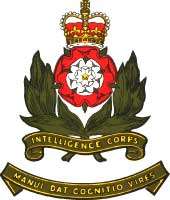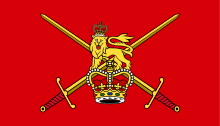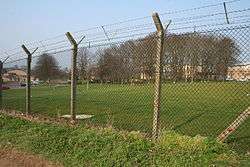Intelligence Corps (United Kingdom)
The Intelligence Corps (Int Corps) is a corps of the British Army. It is responsible for gathering, analysing and disseminating military intelligence and also for counter-intelligence and security. The Director of the Intelligence Corps is a brigadier.
| Intelligence Corps | |
|---|---|
 Badge of the Intelligence Corps | |
| Active | 1914–1929 19 July 1940 – present |
| Allegiance | |
| Branch | |
| Role | Military intelligence |
| Size | 7 Battalions |
| HQ Directorate Intelligence Corps | Chicksands Templer Barracks Maresfield |
| Nickname(s) | Int Corps |
| Motto(s) | Manui Dat Cognitio Vires Knowledge gives strength to the arm |
| Beret | Cypress green |
| March | Rose & Laurel (quick) Purcell’s Trumpet Tune and Ayre (slow) |
| Website | army.mod.uk/intelligence/intelligence.aspx |
| Commanders | |
| Colonel-in-Chief | HRH The Duke of Edinburgh KG, KT, OM, GBE, AC, QSO, PC |
| Colonel Commandant | General Sir Nick Houghton |
| Insignia | |
| Tactical Recognition Flash | |
 |
| Arms of the British Army |
|---|
| Combat Arms |
|
|
| Combat Support Arms |
|
| Combat Services |
|
|
History
In the 19th century, British intelligence work was undertaken by the Intelligence Department of the War Office. An important figure was Sir Charles Wilson, a Royal Engineer who successfully pushed for reform of the War Office's treatment of topographical work.[1]
In the early 1900s intelligence gathering was becoming better understood, to the point where a counter-intelligence organisation (MI5) was formed by the Directorate of Military Intelligence (DoMI) under Captain (later Major-General) Vernon Kell; overseas intelligence gathering began in 1912 by MI6 under Commander (later Captain) Mansfield Smith-Cumming.[2]
First World War
Although the first proposals to create an intelligence corps came in 1905, the first Intelligence Corps was formed in August 1914 and originally included only officers and their servants. It left for France on 12 August 1914.[3] The Royal Flying Corps was formed to monitor the ground, and provided aerial photographs for the Corps to analyse.[4]
Irish War of Independence
During the Irish War of Independence, Intelligence Corps operatives were used in an unsuccessful battle to defeat the Irish Republican Army. The Cairo Gang were overwhelmingly Intelligence Corps operatives. On Bloody Sunday, 1920, twelve of these agents were assassinated at their lodgings by Michael Collins' Squad. Due to this and similar failures, the Intelligence Corps was disbanded in 1929.[4]
Second World War
On 19 July 1940 a new Intelligence Corps was created by Army Order 112 and has existed since that time. The Army had been unprepared for collecting intelligence for deployment to France, and the only intelligence had been collected by Major Sir Gerald Templer. The Corps trained operatives to parachute at RAF Ringway; some of these were then dropped over France as part of the Special Operations Executive (SOE). Intelligence Corps officers were involved in forming the highly-effective Long Range Desert Group, and Corps officer Lt Col Peter Clayton was one of the four founders of the Special Air Service (SAS). Around 40 per cent of British Army personnel at Bletchley Park were in the Intelligence Corps.[5]
The Combined Allied Intelligence Corps as it was known in Malta, began recruiting in 1940 following Italy’s entry into the war on the side of Germany.[6] Among its many responsibilities in the Mediterranean Theatre were debriefing and interrogation of high-ranking prisoners of war in East Africa following Mussolini's invasion of Abyssinia (“Eldoret” P.O.W. Camp no. 365 being one example), counter-intelligence operations following Operation Husky the Allied invasion of Sicily in August 1943, and implementation of the Allied Screening Commission. [7] The Commission was established by Field-Marshal Sir Harold Alexander a few days after the fall of Rome in June 1944 to identify and reimburse Italian civilians who had assisted Allied escapees.[8]
Cold War
The Corps gained its regimental march in 1956, first played at Kneller Hall, the home of the Royal Military School of Music. From August 1957, the Corps first had a permanent cadre of officers; previously all personnel serving in the corps were officers from other parts of the army, on occasional tours. Throughout the Cold War, Intelligence Corps officers and NCOs (with changed insignia) were posted behind the Iron Curtain in East Germany, to join in the intelligence-gathering activities of the British Commanders'-in-Chief Mission to the Soviet Forces in Germany (Brixmis).[9]
Northern Ireland
Many members of the Intelligence Corps served in Northern Ireland during "the Troubles". Units such as the Military Reaction Force, Special Reconnaissance Unit, Force Research Unit and 14 Intelligence Company contained Corps soldiers and officers.[10]
Designation
On 1 February 1985 the corps was officially declared an 'Arm' (combat support) instead of a 'Service' (rear support).[5]
Corps traditions
Intelligence Corps personnel wear a distinctive cypress green beret with a cap badge consisting of a union rose (a red rose with a white centre) between two laurel branches and surmounted by a crown. (According to the late Gavin Lyall, the Intelligence Corps cap badge is referred to jokingly as "a rampant pansy resting on its laurels".) Their motto is Manui Dat Cognitio Vires ("Knowledge gives Strength to the Arm"). The corps' quick march is The Rose & Laurel while its slow march is Henry Purcell's Trumpet Tune & Ayre.[11] Due to the colour of the beret, Intelligence Corps personnel are often referred to as 'Muppets', 'Green Slime', or simply 'Slime' by fellow soldiers.[12]
Locations
Their headquarters, formerly at Maresfield, East Sussex, then Templer Barracks at Ashford, Kent, moved in 1997 to the former Royal Air Force station at Chicksands in Bedfordshire along with the Defence Intelligence and Security Centre (DISC).[11] DISC was renamed as Joint Intelligence Training Group in January 2015.[13]
The Intelligence Corps Museum was created in 1969,[14] and later renamed as the Military Intelligence Museum, now also at Chicksands. As a working military base, the Museum can be visited by appointment only.[15]
Training and promotion
The corps has a particularly high proportion of commissioned officers, many of them commissioned from the ranks, and also a high percentage of female members. Non-commissioned personnel join as an Operator Military Intelligence (OPMI) or Operator Military Intelligence (Linguist) (OPMI(L)). They do basic 14-week military training at either the Army Training Centre, Pirbright, or the Army Training Regiment, Winchester.[16] OPMI soldiers then will complete a 20-week special-to-arm training at Templer Training Delivery Wing, Chicksands, at the end of which they are promoted to Lance Corporal and posted to a battalion.[17]

Structure
1st Intelligence, Surveillance and Reconnaissance Brigade:
- 1 Military Intelligence Battalion – Catterick (Regular Army)[18]
- 5 x MI Companies
- 2 Military Intelligence (Exploitation) Battalion – Trenchard Lines, Upavon (Regular Army)[19]
- 6 x MI Companies
- 3 Military Intelligence Battalion (Reserve) – London
- HQ Company – London
- 31 MI Company – London
- 32 MI Company – London
- 33 MI Company – London
- 34 MI Company – London
- 35 MI Company
- 4 Military Intelligence Battalion – Bulford (Regular Army) - supports 3rd UK Division[20]
- Headquarter Company
- 3 x Multi-Functional Military Intelligence (MFMI) Companies
- Operations Support Military Intelligence Company
- Land Intelligence Fusion Centre, Hermitage
- 5 Military Intelligence Battalion (Reserve) – Coulby Newham
- 6 Military Intelligence Battalion (Reserve) – Manchester
- HQ Company – Manchester
- 61 MI Company – Manchester
- 62 MI Company – Lisburn
- 63 MI Company – Stourbridge
- 7 Military Intelligence Battalion (Reserve) – Bristol
- HQ Company – Bristol
- 71 MI Company – Bristol
- 72 MI Company – Southampton
- 73 MI Company – Thatcham
1st Intelligence, Surveillance and Reconnaissance Brigade is part of 6th Division.
Notable personnel
- Category:Intelligence Corps officers
References
- "Major General Sir Charles William Wilson, 1836-1905". Palestine Exploration Fund. Retrieved 7 December 2011.
- "The spymaster who was stranger than fiction". The Independent. 29 October 1999. Retrieved 5 May 2014.
- Clayton 1996, p. 18-20.
- "History of the Intelligence Corps, p. 3" (PDF). Ministry of Defence. Retrieved 5 May 2014.
- History of the Intelligence Corps, p. 4
- Recorded interview with Captain “C.M.” (Rtd) of the Combined Allied Intelligence Corps (1941–1946) at Sliema, Malta on 7 November 2012
- Recorded interview with Captain “C.M.” (Rtd) of the Combined Allied Intelligence Corps (1941–1946) at Sliema, Malta on 7 November 2012
- Roger Absalom (2005) Allied escapers and the contadini in occupied Italy (1943 – 5), Journal of Modern Italian Studies, 10:4, 413-425, DOI: 10.1080/13545710500314603
- Gibson 2012, p. 57
- "PREM 16/154: Defensive Brief D - Meeting between the Prime Minister and the Taoiseach, 5 April 1974 "Army Plain Clothes Patrols in Northern Ireland"" (PDF). The National Archives. London. Archived from the original (PDF) on 22 February 2011. Retrieved 15 April 2015.
- History of the Intelligence Corps, p. 5
- "Military Slang and Acronyms". Hollinsclough.org.uk. Retrieved 21 August 2017.
- "Bedfordshire - Joint Intelligence Training Group Chicksands". Sanctuary (44): 74. 2015. ISSN 0959-4132.
- "Intelligence Corps Display". www.militaryintelligencemuseum.org. Retrieved 23 May 2020.
- "Military Intelligence Museum". www.militaryintelligencemuseum.org. Retrieved 23 May 2020.
- "ATC Pirbright". Retrieved 5 May 2014.
- "Intelligence Corps opportunities". Ministry of Defence. Retrieved 5 May 2014.
- "1 MILITARY INTELLIGENCE BATTALION". British Army. Retrieved 5 January 2020.
- "2 Military Intelligence (Exploitation) Battalion". British Army. Retrieved 23 August 2018.
- "4 Military Intelligence (MI) Battalion". British Army. Retrieved 23 August 2018.
External links and further reading
- Official website
- Intelligence Corps Association
- 3 MI Bn (V) – London
- 5 MI Bn (V) – Coulby Newham
- Military Intelligence Museum
- The Intelligence Corps in the Second World War The Services 1930 – 1956 at www.BritishMilitaryHistory.co.uk
- Clayton, Anthony (1996). Forearmed: History of the Intelligence Corps. Brassey's (UK) Ltd. ISBN 978-0080377018.
- Gibson, Steve (2012). Live and Let Spy: Brixmis the Last Cold War Mission. The History Press, Stroud, Glos. ISBN 978-0-7524-6580-7.CS1 maint: ref=harv (link)
| Preceded by Royal Army Dental Corps |
Order of Precedence | Succeeded by Royal Army Physical Training Corps |